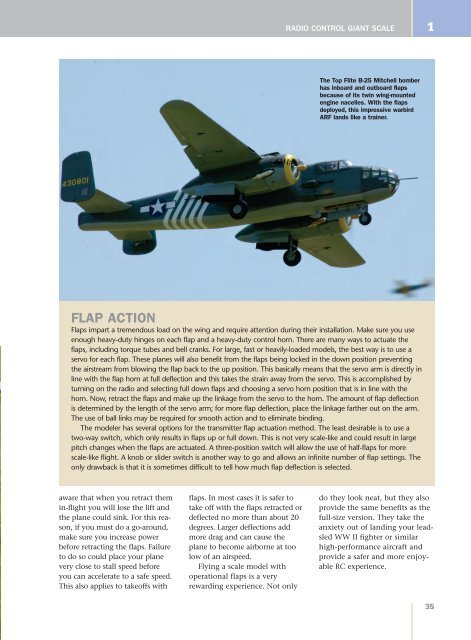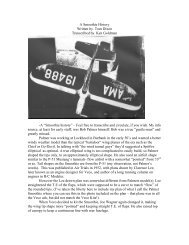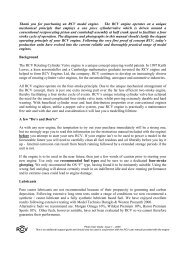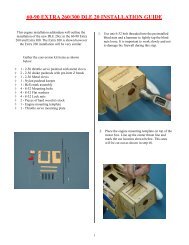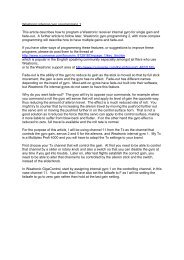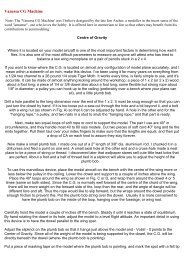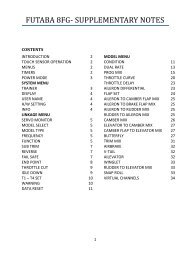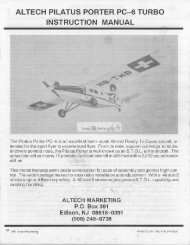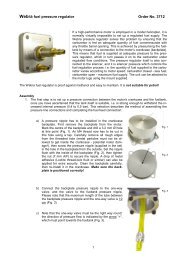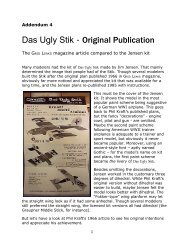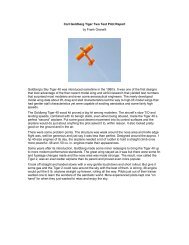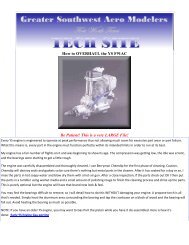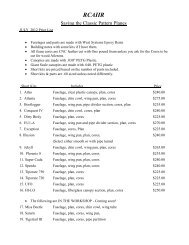Flying with flaps - Model Airplane News
Flying with flaps - Model Airplane News
Flying with flaps - Model Airplane News
You also want an ePaper? Increase the reach of your titles
YUMPU automatically turns print PDFs into web optimized ePapers that Google loves.
ch1flighttechniques 1/28/08 11:08 AM Page 35<br />
RADIO CONTROL GIANT SCALE 1<br />
The Top Flite B-25 Mitchell bomber<br />
has inboard and outboard <strong>flaps</strong><br />
because of its twin wing-mounted<br />
engine nacelles. With the <strong>flaps</strong><br />
deployed, this impressive warbird<br />
ARF lands like a trainer.<br />
FLAP ACTION<br />
Flaps impart a tremendous load on the wing and require attention during their installation. Make sure you use<br />
enough heavy-duty hinges on each flap and a heavy-duty control horn. There are many ways to actuate the<br />
<strong>flaps</strong>, including torque tubes and bell cranks. For large, fast or heavily-loaded models, the best way is to use a<br />
servo for each flap. These planes will also benefit from the <strong>flaps</strong> being locked in the down position preventing<br />
the airstream from blowing the flap back to the up position. This basically means that the servo arm is directly in<br />
line <strong>with</strong> the flap horn at full deflection and this takes the strain away from the servo. This is accomplished by<br />
turning on the radio and selecting full down <strong>flaps</strong> and choosing a servo horn position that is in line <strong>with</strong> the<br />
horn. Now, retract the <strong>flaps</strong> and make up the linkage from the servo to the horn. The amount of flap deflection<br />
is determined by the length of the servo arm; for more flap deflection, place the linkage farther out on the arm.<br />
The use of ball links may be required for smooth action and to eliminate binding.<br />
The modeler has several options for the transmitter flap actuation method. The least desirable is to use a<br />
two-way switch, which only results in <strong>flaps</strong> up or full down. This is not very scale-like and could result in large<br />
pitch changes when the <strong>flaps</strong> are actuated. A three-position switch will allow the use of half-<strong>flaps</strong> for more<br />
scale-like flight. A knob or slider switch is another way to go and allows an infinite number of flap settings. The<br />
only drawback is that it is sometimes difficult to tell how much flap deflection is selected.<br />
aware that when you retract them<br />
in-flight you will lose the lift and<br />
the plane could sink. For this reason,<br />
if you must do a go-around,<br />
make sure you increase power<br />
before retracting the <strong>flaps</strong>. Failure<br />
to do so could place your plane<br />
very close to stall speed before<br />
you can accelerate to a safe speed.<br />
This also applies to takeoffs <strong>with</strong><br />
<strong>flaps</strong>. In most cases it is safer to<br />
take off <strong>with</strong> the <strong>flaps</strong> retracted or<br />
deflected no more than about 20<br />
degrees. Larger deflections add<br />
more drag and can cause the<br />
plane to become airborne at too<br />
low of an airspeed.<br />
<strong>Flying</strong> a scale model <strong>with</strong><br />
operational <strong>flaps</strong> is a very<br />
rewarding experience. Not only<br />
do they look neat, but they also<br />
provide the same benefits as the<br />
full-size version. They take the<br />
anxiety out of landing your leadsled<br />
WW II fighter or similar<br />
high-performance aircraft and<br />
provide a safer and more enjoyable<br />
RC experience.<br />
35


